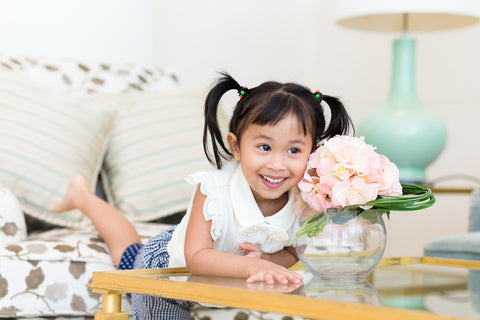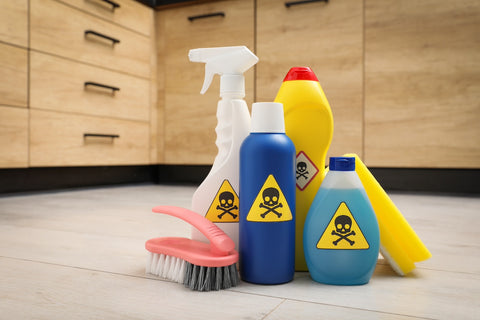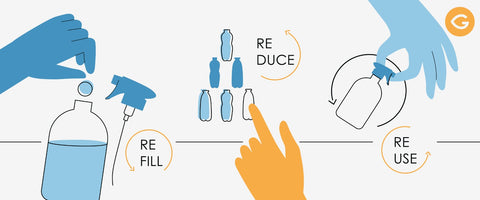1. Tiny Hands, Big Concerns: The Importance of Safe Cleaning Choices
The world is a vast playground for children, filled with endless wonders and curiosities. Every corner they turn, every object they touch, is an opportunity for discovery. However, this innate curiosity also means that they are constantly exposed to various elements in their environment, including household cleaning products. The vulnerability of children to chemical exposures cannot be overstated. Their developing systems, from their respiratory to their neurological pathways, are particularly sensitive to toxins. As such, ensuring that the cleaning products we use around them are safe becomes paramount.
Children's bodies absorb chemicals more readily than adults, making them more susceptible to potential harm. This vulnerability underscores the importance of making informed choices about the cleaning products we bring into our homes. It's not just about cleanliness; it's about safety.
2. Lurking Shadows: Harmful Ingredients Often Found in Cleaners
The cleaning aisle in most stores is a colorful array of bottles promising sparkling surfaces and germ-free environments. But behind these promises often lie a cocktail of chemicals that can be harmful, especially to children. One such chemical is ammonia. While no health effects have been found in humans exposed to typical environmental concentrations of ammonia, high levels can be irritating to the skin, eyes, throat, and lungs. Prolonged exposure can lead to symptoms such as abdominal pain, coughing, skin blistering, and even temporary blindness source.
Another common ingredient in many cleaning products is bleach. While effective as a disinfectant, bleach can be harmful if ingested, especially by children. It's crucial to be aware of these ingredients and understand their potential impacts on children's health.
3. Little Explorers, Big Discoveries: Understanding Kids’ Interaction with Cleaners
Children are natural explorers. Their world is one of touch, taste, and discovery. This means that the bottle of floor cleaner left unattended on the kitchen counter or the detergent pod that looks eerily like a candy can be too tempting to resist. Common scenarios include toddlers pouring liquid cleaners into their bathwater, thinking it's a bubble bath, or preschoolers mistaking brightly colored detergent pods for sweets.
It's not just about ingestion. Children can also get chemical burns from touching certain products or inhale fumes from others. Understanding these interactions is the first step in preventing potential hazards.
4. Green Clean Dream: Eco-friendly and Child-Safe Cleaning Alternatives
In a world increasingly conscious of its environmental footprint, there's a growing demand for eco-friendly cleaning alternatives. These products, often made with plant-based and biodegradable ingredients, offer the dual benefit of being safe for the planet and our children. They don't compromise on effectiveness either. For instance, consider switching to laundry sheets that are not only effective but also safe for kids. You can find more about these eco-friendly alternatives and their ingredients here.
The shift towards green cleaning isn't just a trend; it's a necessary step towards a sustainable and safe future. By choosing eco-friendly products, we're not only protecting our children but also ensuring a healthier planet for them.
5. Scented Secrets: The Hidden Dangers of Artificial Fragrances
That fresh linen or ocean breeze scent that wafts from your freshly cleaned home might not be as innocent as it seems. Many cleaning products use artificial fragrances that can contain a myriad of chemicals. These chemicals can lead to respiratory issues, skin irritations, and other health concerns, especially in children.
It's essential to be wary of products that list 'fragrance' as an ingredient without further specification. Opting for products with natural fragrances or those that are fragrance-free can be a safer choice, especially in homes with children.
6. Labels and Labyrinths: Decoding Cleaner Ingredient Lists
Deciphering the ingredient list on cleaning products can feel like navigating a maze. However, with a bit of knowledge and vigilance, you can make informed choices. Look out for red flags such as 'ammonia', 'bleach', or vague terms like 'fragrance'. When in doubt, a quick online search or consultation with experts can provide clarity.
Furthermore, companies that prioritize safety and transparency often have detailed ingredient lists available online. For instance, if you're curious about the ingredients in a particular multi-surface cleaner, you can check here.
7. Beyond the Bottle: Safe Storage Tips to Childproof Your Cleaning Supplies
Safety doesn't stop at choosing the right products; it extends to how we store them. Keeping cleaning supplies out of reach of children is crucial. Consider using high shelves or locked cabinets. Additionally, opting for products with child-resistant packaging can add an extra layer of protection.
Remember, children are curious by nature. Even the most vigilant parent can't watch them every second of the day. Hence, safe storage solutions are a must.
8. Clean Play: Making Cleaning a Safe and Fun Activity with Kids
Involving children in cleaning tasks can be both fun and educational. It teaches them responsibility and the value of cleanliness. However, it's essential to ensure their safety. Consider using DIY cleaning solutions made with ingredients like vinegar, baking soda, or essential oils. Not only are these solutions effective, but they also allow kids to participate without the risk of chemical exposure.
Moreover, making these solutions can be a fun activity in itself. Children can learn about the cleaning properties of different natural ingredients and even enjoy the process of creating their own cleaners.
9. An Ounce of Prevention: Steps to Take in Case of Accidental Ingestion or Exposure
Accidents happen. In the unfortunate event that a child comes into direct contact with a cleaning product, it's crucial to know the steps to take. Firstly, remain calm. If the product has been ingested, avoid inducing vomiting unless advised by a medical professional. Rinse any affected areas with plenty of water and seek medical attention immediately. Always have emergency contact numbers, such as the local poison control center, readily available.
Prevention is always better than cure. By being informed and vigilant, we can ensure our children's safety while maintaining a clean and healthy home.




